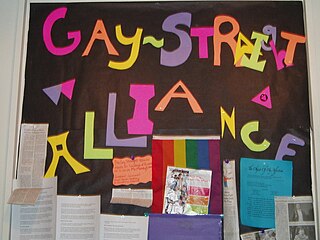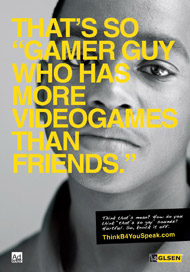Gay bashing is an attack, abuse, or assault committed against a person who is perceived by the aggressor to be gay, lesbian, bisexual, transgender or queer (LGBTQ+). It includes both violence against LGBT people and LGBT bullying. The term covers violence against and bullying of people who are LGBT, as well as non-LGBT people whom the attacker perceives to be LGBT.
GLSEN is an American education organization working to end discrimination, harassment, and bullying based on sexual orientation, gender identity and gender expression and to prompt LGBT cultural inclusion and awareness in K-12 schools. Founded in 1990 in Boston, Massachusetts, the organization is now headquartered in New York City and has an office of public policy based in Washington, D.C.

A gay–straight alliance, gender-sexuality alliance (GSA) or queer–straight alliance (QSA) is a student-led or community-based organization, found in middle schools, high schools, colleges, and universities. These are primarily in the United States and Canada. Gay–straight alliance is intended to provide a safe and supportive environment for lesbian, gay, bisexual, transgender, and all LGBTQ+ individuals, children, teenagers, and youth as well as their cisgender heterosexual allies. The first GSAs were established in the 1980s. Scientific studies show that GSAs have positive academic, health, and social impacts on schoolchildren of a minority sexual orientation and/or gender identity. Numerous judicial decisions in United States federal and state court jurisdictions have upheld the establishment of GSAs in schools, and the right to use that name for them.

LGBT culture is a culture shared by lesbian, gay, bisexual, transgender, and queer individuals. It is sometimes referred to as queer culture, while the term gay culture may be used to mean either "LGBT culture" or homosexual culture specifically.
The origin of the LGBT student movement can be linked to other activist movements from the mid-20th century in the United States. The Civil Rights Movement and Second-wave feminist movement were working towards equal rights for other minority groups in the United States. Though the student movement began a few years before the Stonewall riots, the riots helped to spur the student movement to take more action in the US. Despite this, the overall view of these gay liberation student organizations received minimal attention from contemporary LGBT historians. This oversight stems from the idea that the organizations were founded with haste as a result of the riots. Others historians argue that this group gives too much credit to groups that disagree with some of the basic principles of activist LGBT organizations.
Ally Week is a national youth-led effort encouraging students to be allies with the LGBT members of their community in standing against bullying and harassment. It takes place in K-12 schools and colleges. It is led in the same spirit as Day of Silence: to educate on anti-LGBT harassment issues. Ally Week is usually held in September or October.

The questioning of one's sexual orientation, sexual identity, gender, or all three is a process of exploration by people who may be unsure, still exploring, or concerned about applying a social label to themselves for various reasons. The letter "Q" is sometimes added to the end of the acronym LGBT ; the "Q" can refer to either queer or questioning.

Janet Jackson is an American pop and R&B singer and actress. Jackson garnered a substantial gay following during the 1990s as she gained prominence in popular music. Recognized as a long-term ally of the LGBT community, Jackson received the GLAAD Media Award for Outstanding Music Album for her Grammy Award-winning sixth studio album The Velvet Rope (1997), which spoke out against homophobia and embraced same-sex love. In 2005, Jackson received the Humanitarian Award from the Human Rights Campaign and AIDS Project Los Angeles in recognition of her involvement in raising funds for AIDS Charities and received the Vanguard Award at the 19th Annual GLAAD Media Awards in 2008. In June 2012, Jackson announced she was executive producing a documentary on the lives of transgender people around the world titled Truth, saying she agreed to sign on to help stop discrimination against the transgender community.
Various topics in medicine relate particularly to the health of lesbian, gay, bisexual, transgender, queer, intersex and asexual (LGBTQIA) individuals as well as other sexual and gender minorities. According to the US National LGBTQIA+ Health Education Center, these areas include sexual and reproductive health, mental health, substance use disorders, HIV/AIDS, HIV-related cancers, intimate partner violence, issues surrounding marriage and family recognition, breast and cervical cancer, inequities in healthcare and access to care. In medicine, various nomenclature, including variants of the acronym LGBTQIA+, are used as an umbrella term to refer to individuals who are non-heterosexual, non-heteroromantic, or non-cis gendered. Specific groups within this community have their own distinct health concerns, however are often grouped together in research and discussions. This is primarily because these sexual and gender minorities groups share the effects of stigmatization based on their gender identity or expression, and/or sexual orientation or affection orientation. Furthermore, there are subpopulations among LGBTQIA+ groups based on factors such as race, ethnicity, socioeconomic status, geographic location, and age, all of which can impact healthcare outcomes.
Research has found that attempted suicide rates and suicidal ideation among lesbian, gay, bisexual, and transgender (LGBT) youth are significantly higher than among the general population.

LGBT sex education is a sex education program within a school, university, or community center that addresses the sexual health needs of LGBT people.
Youth pride, an extension of the Gay pride and LGBT social movements, promotes equality amongst young members of the Lesbian, Gay, Bisexual, Transgender, Intersex, and Queer (LGBTIQ+) community. The movement exists in many countries and focuses mainly on festivals and parades, enabling many LGBTIQ+ youth to network, communicate, and celebrate their gender and sexual identities.

Historically speaking, lesbian, gay, bisexual, and transgender (LGBT) people have not been given equal treatment and rights by both governmental actions and society's general opinion. Much of the intolerance for LGBT individuals come from lack of education around the LGBT community, and contributes to the stigma that results in same-sex marriage being legal in few countries (31) and persistence of discrimination, such as in the workplace.
Minority stress describes high levels of stress faced by members of stigmatized minority groups. It may be caused by a number of factors, including poor social support and low socioeconomic status; well understood causes of minority stress are interpersonal prejudice and discrimination. Indeed, numerous scientific studies have shown that when minority individuals experience a high degree of prejudice, this can cause stress responses that accrue over time, eventually leading to poor mental and physical health. Minority stress theory summarizes these scientific studies to explain how difficult social situations lead to chronic stress and poor health among minority individuals.
Research shows that a disproportionate number of homeless youth in the United States identify as lesbian, gay, bisexual or transgender, or LGBT. Researchers suggest that this is primarily a result of hostility or abuse from the young people's families leading to eviction or running away. In addition, LGBT youth are often at greater risk for certain dangers while homeless, including being the victims of crime, risky sexual behavior, substance use disorders, and mental health concerns.

The following outline offers an overview and guide to LGBT topics.
LGBT psychology is a field of psychology of surrounding the lives of LGBTQ+ individuals, in the particular the diverse range of psychological perspectives and experiences of these individuals. It covers different aspects such as identity development including the coming out process, parenting and family practices and support for LGBTQ+ individuals, as well as issues of prejudice and discrimination involving the LGBT community.
Due to the increased vulnerability that lesbian, gay, bisexual, and transgender (LGBT) youth face compared to their non-LGBT peers, there are notable differences in the mental and physical health risks tied to the social interactions of LGBT youth compared to the social interactions of heterosexual youth. Youth of the LGBT community experience greater encounters with not only health risks, but also violence and bullying, due to their sexual orientation, self-identification, and lack of support from institutions in society.
Bullying of lesbian, gay, bisexual, or transgender (LGBT) people, particularly LGBT youth, involves intentional actions toward the victim, repeated negative actions by one or more people against another person, and an imbalance of physical or psychological power.
People who are LGBT are significantly more likely than those who are not to experience depression, PTSD, and generalized anxiety disorder.






